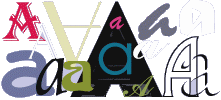| Linguistics 105 * Words and Sounds |
| Lecture Number Seventeen |
| (What
Your Parents Failed to Tell You About)
The Birds and the Bees |
- Language Criteria
- Phonological or other symbolic medium (e.g. hand signs) with allophonic variations.
- Lexicon--arbitrary signs with:
- token
- meaning
- referent
- Recombinatory morphology and syntax such that
- operates on grammatical categories distinct from lexical categories;
- the category system and symbol system are distinct and operate separately, so that there are:
- Zero and empty morphemes;
- Allomorphy (not iconicism).
- Rigid syntactic order with regular variations
- Innate + learned acquisition
- based on innate parameters set during acquisition
- which occurs at a fixed developmental
stage.
- The Properties of Animal Communication Systems
- The Birds and the Bees (or Beasts)
- Bees
- symbols with referents but arbitrariness and meaning in question
- acquisition purely innate
- no recombinatory morphology and syntax
- dances
- round dance
- distance: within 5 meters
- direction: no direction
- quality: intensity and no. of repetitions
- sickle dance
- distance: 5-20 meters
- direction: through the axis of the "8"
- quality: intensity and no. of repetitions
- tail-wagging dance
- distance: 20+ meters
- direction: through the axis of the "8"
- quality: intensity and no. of repetitions
- Songbirds
- Bird song vs. Bird calls
- Type of bird songs
- European cuckoo: All innate. Raised in isolation or even if deafened, it sings the same song
- Bullfinch: Almost completely learned. Bullfinches raised with canaries sing canary songs
- Chaffinch: Half innate, half learned. Females injected with testosterone will sing the male song
- Nature of bird songs
- arbitrary symbols with referents but no indication of meaning
- acquisition innate + learned in some species (chaffinch)
- no recombinatory morphology and syntax
- dialects (show learning??)
- Four topics (no morphological categories: Tense, Number, etc.)
- Food
- Danger
- Mating
- Dominance (threats)
- Iconic cues, not arbitrary symbols with distinct sense and reference.
- Gravity = direction of sun; time-length = distance (bees)
- Excitation = seriousness of threat (wild pongids)
- Bared teeth = bite threat (dogs, etc.)
- Emotional (limbic) rather than semantic (cortical)
- Acquisition
- Innate or
- Strict imitation of parents
- Pragmatic communication: no reflexive function (talking to oneself)
- Conclusions
- Indications of symbolic media
- No indication of semantics; borderline indication of arbitrary signs
- No recombinatory morphology or syntax
- Superficial innate + learned acquisition in chaffinches only
- The Properties of Language and Communication
- See Hockett's 'Design Features' (LF 2.1 Animal communication: true language?)
- Extended Properties of Linguistic Communication

- Medium of Communication: Linguistic symbols (sounds), like graphic symbols: letters, are categories, not tokens. The tokens of linguistic symbols are analogous to graphic representations of them, which may be any size, of an enormous variety of shapes, colors, aligned in any direction. Sounds may be of any pitch, volume, nasality and may be influenced by accent, lisping and other variation.
- Semanticity (a signal system: X means Y). However, remember what we have learned about the unusual semanticity of grammatical morphemes (the Separation Hypothesis)
- Pragmatic function: Hockett says it is communication but the how do we explain talking to oneself? Could the function be self-expression?
- Limit of Lower, Untrained Animals
- Reciprocity (sender = receiver, receiver = sender)
- Parental Acquisition (but the question is: How is the system acquired?)
- Limits on Trained Pongids
- Productivity by recombination of symbols (recursive rule system); no limit on topic
- Locational Displacement: talk about things not present
- Arbitrariness: Signs may be conventional, not iconic
- The Unique Nature of the Linguistic Symbol
- Temporal Displacement: talk about things in the past, future or which do not even exist (unicorn, ghosts, etc.)
- Categorial Abstractions, featurally defined -- A -- all the same
- Paradigmatic relations requiring deductive logic
- Parallel processing: simultaneous sound, symbol, structure, logic, meaning
- Generation of "Grammar" in acquisition, not rote learning
- Distinct meanings and references
- Conclusion
- There is no doubt that other species have communications systems but none of those systems have the basic properties of a natural (human) language. There is evidence that animals learn their systems of calls and signals both by innate mechanisms and by learning in ways verys similar to the way humans learn language. However, the explosion of language learning which occurs in human children of approximately the age of 2 is not paralleled elsewhere in the animal kingdom.